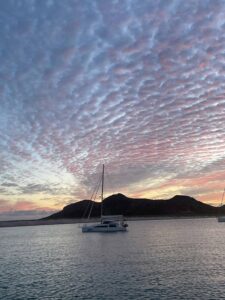For centuries, explorers have ventured south of the 40th parallel by boat, navigating uncharted waters and leaving behind legacies tied to iconic ship names. Some of the most celebrated vessels in history are those that reached the New World, playing pivotal roles in discovery, conquest, and legend. The exploration of South Florida, the Caribbean, Cuba, and the Bahamas was especially crucial during the age of European colonization and expansion. These waters witnessed the daring adventures of humanity’s greatest navigators, who forever changed the course of history. Follow the sailing adventures of some of the great explorers of humanity along the southern navigation territories.
Here are some significant ships and their voyages to the southern navigation territories:
1. Santa María, Pinta, and Niña (1492)
On his first voyage in 1492, Christopher Columbus sailed with the Santa María, Pinta, and Niña and reached the Bahamas, landing on an island he named San Salvador. He then continued to explore parts of Cuba and Hispaniola. These ships marked the beginning of European contact with the Caribbean and opened exploration in the region. On subsequent voyages he explored Puerto Rico, Jamaica and the Greater Antilles.
2. La Navidad (1492-1493)
Santa María ran aground on Hispaniola, leading Columbus to establish a settlement called La Navidad. The Pinta and Niña continued to explore the northern coasts of Cuba and nearby islands. Though not a ship per se, the wreck of the Santa María was a pivotal part of early exploration and settlement efforts.
3. San Juan Bautista (1513)
Captain Juan Ponce de León sailed on this voyage to explore the region, and in 1513, he became the first European to land on what is now Florida, near the area of modern-day St. Augustine. He also named the land “La Florida” and explored the Florida Keys and the Gulf Stream, extending his search for the mythical Fountain of Youth into the Bahamas.
4. La Trinidad (1519)
Although Captain Diego Velázquez himself remained in Cuba, he was instrumental in organizing expeditions from Cuba that led to the exploration of the Yucatán Peninsula and parts of the Gulf of Mexico. His base in Cuba was crucial for launching further exploratory and colonization efforts in the region.
5. Nuestra Señora de Atocha (1622)
Though not primarily a vessel of exploration, the Atocha was part of a Spanish treasure fleet that carried goods between the Caribbean and Spain. It sank off the coast of the Florida Keys, and its wreck is a significant part of the region’s history, emphasizing the role of the Spanish in establishing trade and transport networks throughout the Caribbean and Florida.
6. HMS Providence (1790s)
After the infamous Bounty mutiny, Captain William Bligh commanded the Providence on a mission to transport breadfruit plants from Tahiti to the Caribbean. The journey included navigation through parts of the Caribbean, including Jamaica and the Bahamas, to establish crops for plantation economies.
7. HMS Havana (1762)
During the Seven Years’ War, the British captured Havana, Cuba, in 1762, and the HMS Havana was one of several Royal Navy ships involved in the blockade and eventual takeover. The event marked a critical moment in the contest for dominance in the Caribbean, with Havana being a strategic prize for both the Spanish and British.
And last but never forgotten…
8. Black Pearl (Pirate Legend)
Although fictional, the Black Pearl became globally known through the Pirates of the Caribbean film franchise. As Captain Jack Sparrow’s legendary ship, it captured the imaginations of millions.
Modern boating to the Caribbean
 Today Boaters are lucky to have hundreds of years of charts, stories and exploration accounts to follow. If you are planning to winter in the south, we have lots of resources for you to make the trip a successful voyage. Check out our resources:
Today Boaters are lucky to have hundreds of years of charts, stories and exploration accounts to follow. If you are planning to winter in the south, we have lots of resources for you to make the trip a successful voyage. Check out our resources:
Boating from Canada to Florida: Tips for heading south
Tips to Selling Navipro insurance
Boating from Canada to Florida: Key tips for heading south
Boat Insurance for southern navigation trips
For boaters venturing into southern waters, our Southern Navigation boat insurance offers:
- Multiple navigational zones that span from the Atlantic Eastern Seaboard to the Southern Caribbean Sea, including a Small Vessel extension that covers North American inland waterways and coastal areas up to 3 miles offshore. You can find additional details on our Navigational Territories page.
- Expanded Southern navigational territories along the West Coast.
- Protection & Indemnity Liability – option to increase.
- Coverage for vessels registered in Canada and the U.S., provided the vessel is owned by a Canadian resident.
Set sail to the southern navigation territories
These ships were crucial in exploring the Caribbean, South Florida, and the Bahamas, mapping the region and establishing trade routes that paved the way for European colonization. Their bravery and curiosity have made it possible for Canadians to sail to Florida and beyond.
For modern sailors, venturing from Canada to the Caribbean is a journey that embodies the same spirit of courage and adventure as those who came before. Embracing the call of the open sea, navigating changing weather, and exploring new horizons requires bravery and a deep respect for the ocean’s power. So set your course southward with confidence, knowing that you are part of a legacy of exploration—charting your own path toward discovery and unforgettable experiences.
The end! ⛵️⚓️🏴☠️🌊🪸⛴️
Featured Image: Photo by Omar Eagle on Unsplash








